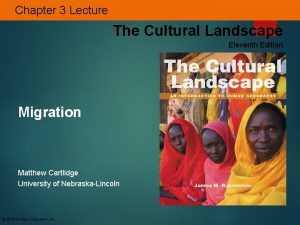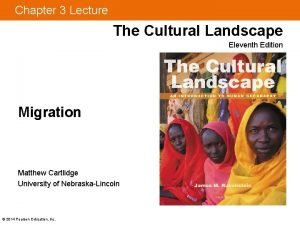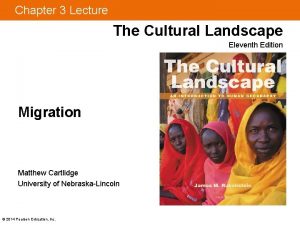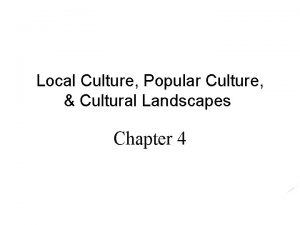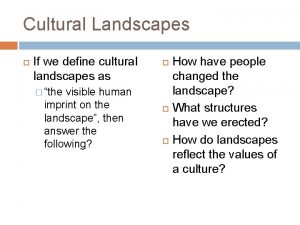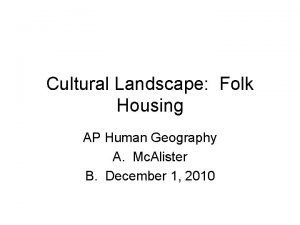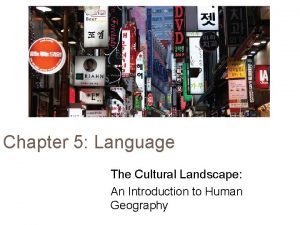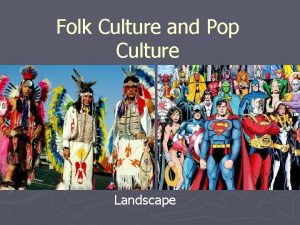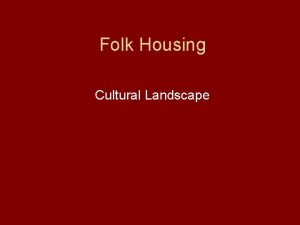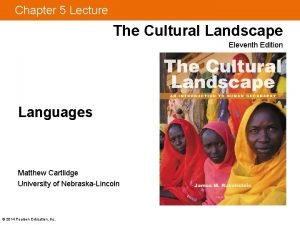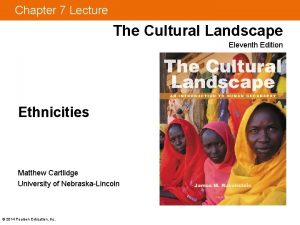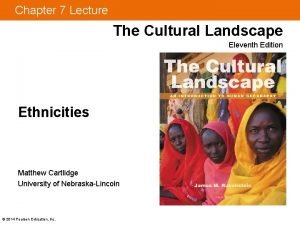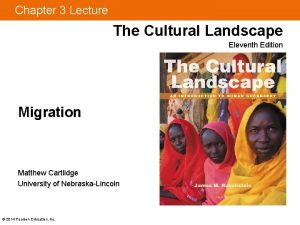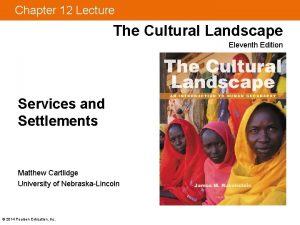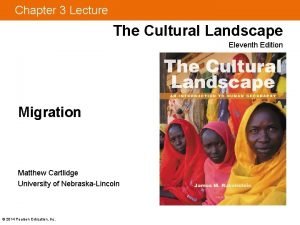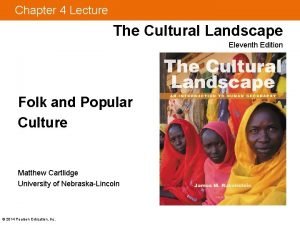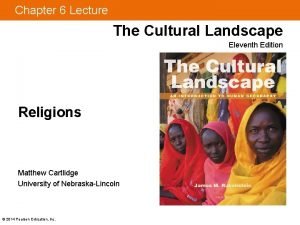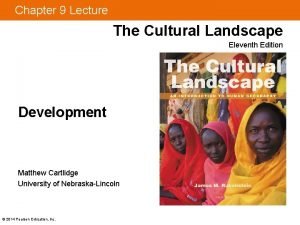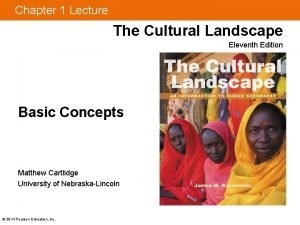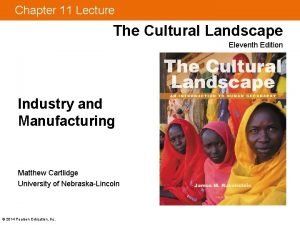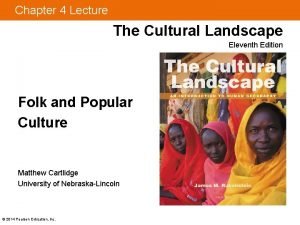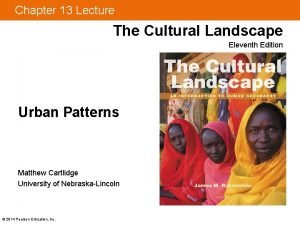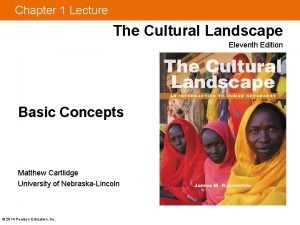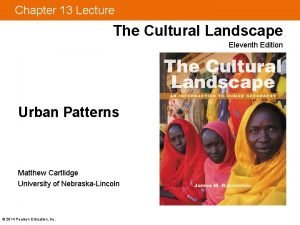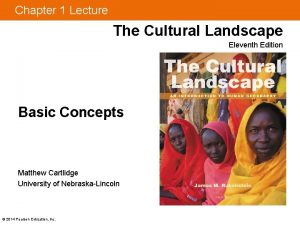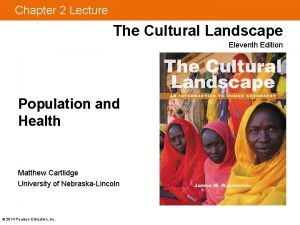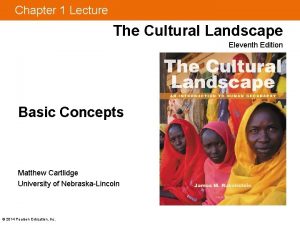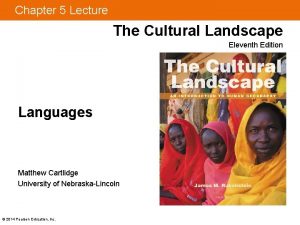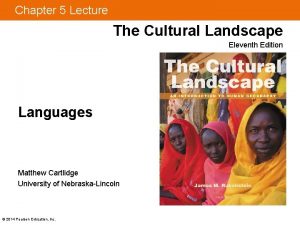Chapter 5 Lecture The Cultural Landscape Eleventh Edition























































- Slides: 55

Chapter 5 Lecture The Cultural Landscape Eleventh Edition Languages Matthew Cartlidge University of Nebraska-Lincoln © 2014 Pearson Education, Inc.

Key Issues • Where are folk languages distributed? • Why is English related to other languages? • Why do individual languages vary among places? • Why do people preserve local languages? © 2014 Pearson Education, Inc.

Learning Outcomes • 5. 1. 1: Name the largest language families. • 5. 1. 2: Identify the names and distribution of the two largest language families. • 5. 1. 3: Identify the names and distribution of the largest language families in addition to Indo-European and Sino-Tibetan. • 5. 2. 1: Learn the distribution of the Germanic and Indo-Iranian branches of Indo-European. © 2014 Pearson Education, Inc.

Learning Outcomes • 5. 2. 2: Learn the distribution of the Balto-Slavic and Romance branches of Indo-European. • 5. 2. 3: Understand the origin and diffusion of English. • 5. 2. 4: Understand the two theories of the origin and diffusion of Indo-European. • 5. 3. 1: Describe the main dialects in the United States. © 2014 Pearson Education, Inc.

Learning Outcomes • 5. 3. 2: Understand the main ways that British and U. S. English dialects vary. • 5. 3. 3: Understand why it is sometimes difficult to distinguish between a language and a dialect. • 5. 4. 1: Understand how several countries peacefully embrace more than one language. • 5. 4. 2: Understand what is meant by an isolated language and an extinct language. © 2014 Pearson Education, Inc.

Learning Outcomes • 5. 4. 3: Understand why the number of Celtic speakers has declined and how the languages are being preserved. • 5. 4. 4: Understand the concept of a lingua franca. • 5. 4. 5: Understand how English has diffused to other languages. • 5. 4. 6: Understand the role of Spanish and French and North America. © 2014 Pearson Education, Inc.

Where Are Languages Distributed? • Language is a system of communication through speech, a collection of sounds that a group of people understands to have the same meaning. • Literary tradition refers to a system of written communication. • Many countries designate at least one official language to be used for official documents and public objects—e. g. , road signs and money. © 2014 Pearson Education, Inc.

Where Are Languages Distributed? • World’s languages organized into: – Language Families: collection of languages related through a common ancestral language – Language Branches: collection of languages within a family related through a common ancestral language. Differences are not as significant or as old as between families. – Language Groups: collection of languages within a branch that share a common origin in the relatively recent past and display similar grammar and vocabulary. © 2014 Pearson Education, Inc.

Where Are Languages Distributed? • Classification of Languages – 2/3 of the world’s population speak a language that belongs to the Indo-European or Sino. Tibetan language family. – 2 to 6 percent of the world’s population speak a language that fits into one of seven other language families. – Remainder of population speaks a language belonging to one of 100 smaller families. © 2014 Pearson Education, Inc.

© 2014 Pearson Education, Inc.

Where Are Languages Distributed? • Distribution of Language Families – The two largest language families are… 1. Indo-European – Predominate language family in Europe, South Asia, North America and Latin America. 2. Sino-Tibetan – Encompasses languages spoken in the People’s Republic of China and several smaller countries in Southeast Asia. » No single Chinese language » Mandarin is the most-used language in the world and the official language of both the People’s Republic of China and Taiwan. © 2014 Pearson Education, Inc.

© 2014 Pearson Education, Inc.

Where Are Languages Distributed? • Other Asian Language Families – Several other language families spoken by large numbers of people in East and Southeast Asia. • Isolation on islands and peninsulas contributed to overall independent development. – – – © 2014 Pearson Education, Inc. Austronesian Austro-Asiatic Tai Kadai Japanese Korean

Where Are Languages Distributed? • Languages of Southwest Asia and North Africa and Central Asia – Two largest language families are… 1. Afro-Asiatic – Arabic is major language. » Official language in 24 countries of S. W. Asia and North Africa » One of the six official languages in U. N. 2. Altaic – – © 2014 Pearson Education, Inc. Altaic language with most speakers is Turkish. Altaic language became official language of several countries that gained independence when Soviet Union broke up—e. g. , Azerbaijan, Kazakhstan, and Turkmenistan.

Where Are Languages Distributed? • African Language Families – More than 1, 000 distinct languages have been documented. • Several thousand dialects recognized. • Most lack a written tradition. – Niger-Congo • Swahili – First language of 800, 000 people – Official language of Tanzania – Spoken by 30 million Africans » Language used to speak with outsiders from different villages © 2014 Pearson Education, Inc.

© 2014 Pearson Education, Inc.

Why Is English Related to Other Languages? • Distribution of Indo-European Branches – Four most widely spoken branches 1. Germanic branch – Spoken primarily in northwestern Europe and North America – Divides into High and Low Germanic subgroups » English is classified in the Low Germanic group 2. Indo-Iranian branch – Spoken primarily in South Asia – Most speakers of the language branch – Subdivided into eastern group (Indic) and western group (Iranian) © 2014 Pearson Education, Inc.

© 2014 Pearson Education, Inc.

© 2014 Pearson Education, Inc.

Why Is English Related to Other Languages? • Distribution of Indo-European Branches – Four most widely spoken branches 3. Balto-Slavic branch – Spoken primarily in Eastern Europe – Divided into… » East Slavic and Baltic Groups: most widely used language is Russian followed by Ukrainian and Belarusan. » West and South Slavic Groups: most spoken west Slavic language is Polish followed by Czech and Slovak, while the most widely spoken south language is Serbo-Croatian. © 2014 Pearson Education, Inc.

Why Is English Related to Other Languages? • Distribution of Indo-European Branches – Four most widely spoken branches 4. Romance branch – Spoken primarily in southwestern Europe and Latin America – Most widely used are Spanish, Portuguese, French, and Italian. » Regions where spoken languages tend to correspond to the political boundaries of Spain, Portugal, France, and Italy © 2014 Pearson Education, Inc.

© 2014 Pearson Education, Inc.

Why Is English Related to Other Languages? • Origin and Diffusion of Language Families – Modern English has evolved primarily from the language spoken by three Germanic tribes invading the British Isles. 1. Angles- from southern Denmark 2. Jutes- from northern Denmark 3. Saxons- from northwestern Germany – Over time, others invaded England their languages influenced the basic English. • • © 2014 Pearson Education, Inc. Vikings from present-day Norway Normans from present-day Normandy in France spoke French.

© 2014 Pearson Education, Inc.

Why Is English Related to Other Languages? • Origin and Diffusion of Language Families – English diffuses across the world. • English language migrated with the people of England when they established colonies over four centuries. – English is an official language in most former British colonies. • Diffusion to North America – First successful colony was Jamestown, VA, in 1607. – Defeat of France by England secured English as the dominant language in North America. – United States responsible for diffusing English to several places—e. g. , Philippines. © 2014 Pearson Education, Inc.

Why Is English Related to Other Languages? • Origin and Diffusion of Language Families – Indo-European • It is theorized that Germanic, Romance, Balto. Slavic, and Indo-Iranian languages all stemmed from a common ancestral language. – Proto-Indo-European • Linguists and anthropologists continue to debate when and where the Proto-Indo-European language originated and how it diffused. – Two Theories 1. Nomadic Warrior Hypothesis 2. Sedentary Farmer Hypothesis © 2014 Pearson Education, Inc.

© 2014 Pearson Education, Inc.

© 2014 Pearson Education, Inc.

Why Do Individual Languages Vary among Places? • Dialects of English – A dialect is a regional variation of a language distinguished by distinctive vocabulary, spelling, and pronunciation. – Boundaries of where regional words are used can be mapped; such a word usage boundary is known as an isogloss. – Large number of speakers and widespread distribution in the United States has contributed to the existence of a large number of English dialects. © 2014 Pearson Education, Inc.

Why Do Individual Languages Vary among Places? • Dialects in the United States – The 13 original colonies can be grouped into three dialect regions. 1. New England – Inhabited by settlers from England 2. Southeastern – About ½ came from southeastern England, while the others represented a diversity of social-class backgrounds. 3. Midlands – Most diverse group—e. g. , Quakers from north of England, Scots and Irish, German, Dutch, and Swedish migrants. © 2014 Pearson Education, Inc.

Why Do Individual Languages Vary among Places? • Current Dialect Differences in the East – Some English words are specific to a dialect. • Rural life • Food • Objects from daily activities – Language differences tend to be greatest in rural areas because of limited interaction with people from other dialect regions. – Mass media has reduced the number of regionally distinctive words. © 2014 Pearson Education, Inc.

© 2014 Pearson Education, Inc.

© 2014 Pearson Education, Inc.

© 2014 Pearson Education, Inc.

Why Do Individual Languages Vary among Places? • Dialects in the United Kingdom – Languages with multiple dialects may recognize one as the standard language that is widely recognized as the most acceptable for government, business, education, and mass communication. • Ex. England’s is known as British Received Pronunciation (BRP). © 2014 Pearson Education, Inc.

Why Do Individual Languages Vary among Places? • British and American English Dialects – English language is noticeably different than English spoken in England in three ways. 1. Vocabulary – Settlers in America encountered many new objects and experiences not present in England. – Climate and geography differ significantly between England America. 2. Spelling – Noah Webster sought to make English used in America distinct from England to reduce cultural dependence by changing spellings of words in his dictionary. 3. Pronunciation – Chief cause was limited interaction between speakers of varying dialects. © 2014 Pearson Education, Inc.

Why Do Individual Languages Vary among Places? • Distinguishing between Languages and Dialects – Dialect or language • Increasingly difficult to determine whether two languages are distinct or whether they are dialects of the same language. • Several languages in Italy that have been traditionally classified as dialects of Italian are now viewed by Ethnologue as distinct enough to merit consideration as a new language. – Examples include Emiliano-Romagnolo, Liguri, Lombard, and Sicilian. © 2014 Pearson Education, Inc.

Why Do People Preserve Local Languages? • Language Diversity – Difficulties can arise at the boundary between two languages. • Varying degrees of difficulties – Belgium » Southern Belgians (Walloons) speak French. » Northern Belgians (Flemings) speak Flemish. » Pressure from Flemish speakers led to the division of Belgium into two independent regions with each controlling their own cultural affairs, public health, road construction, and urban development. – Switzerland » Cont’d on next slide. © 2014 Pearson Education, Inc.

© 2014 Pearson Education, Inc.

Why Do People Preserve Local Languages? • Language Diversity – Difficulties can arise at the boundary between two languages. • Varying degrees of difficulties – Switzerland » Peacefully exists with multiple languages. » Switzerland attributes success to decentralized government, in which local authorities hold most of the power, and decisions are frequently made on a local level by voter referenda. » Four official languages—German (65%), French (18%), Italian (10%), and Romansh (1%) © 2014 Pearson Education, Inc.

© 2014 Pearson Education, Inc.

Why Do People Preserve Local Languages? • Isolated Languages – An isolated language is one unrelated to any other and therefore not attached to any language family. • Arise from lack of interaction with speakers of other languages. • Ex. Basque in Europe – Only language currently spoken that survives since the period before the arrival of Indo-European speakers. – First language of 666, 000 people in the Pyrenees Mountains of northern Spain and southwestern France. » Mountain chain serving as a natural barrier to diffusion helped them preserve their language. • Ex. Icelandic – Language has changed less than any other Germanic language. © 2014 Pearson Education, Inc.

Why Do People Preserve Local Languages? • Extinct and Revived Languages – An extinct language is one that is no longer spoken or read in daily activities by anyone in the world. • Presently, 473 languages nearly extinct – – – 46 in Africa 182 in Americas 84 in Asia 9 in Europe 152 in Pacific • Ex. Native Americans – 74 languages extinct in the United States that were once spoken by Native Americans. © 2014 Pearson Education, Inc.

Why Do People Preserve Local Languages? • Preserving Endangered Languages: Celtic – Linguists expect hundreds of languages will become extinct during the twenty-first century. • Only about 300 languages are said to be safe from extinction. – Celtic Language • Significant to English speakers because of its primacy in the British Isles. • Survives only in remote parts of Scotland, Wales, and Ireland, and on the Brittany peninsula of France. • Celtic speakers must work hard to preserve their language in face of diffusion by others who have greater political and economic strength. © 2014 Pearson Education, Inc.

Why Do People Preserve Local Languages? • Global Dominance of English – A lingua franca is a language of international communication. • Ex. English – – First language of 328 million people Spoken fluently by another ½ to 1 billion people. Official language in 57 countries People in smaller countries learn English to participate more fully in the global economy and culture. • Other Examples – – © 2014 Pearson Education, Inc. Swahili in East Africa Hindi in South Asia Indonesian in Southeast Asia Russian in former Soviet Union.

Why Do People Preserve Local Languages? • Global Dominance of English – English on the Internet • Majority of content on Internet is in English. – Dominance of content in English is waning. » Percentage of English-language online users declined from 46 percent in 2000 to 27 percent in 2010. – Mandarin will likely replace English as the most-frequently used online language before 2020. © 2014 Pearson Education, Inc.

© 2014 Pearson Education, Inc.

Why Do People Preserve Local Languages? • Global Dominance of English – Expansion Diffusion of English • Recent growth in the use of English is an example of expansion diffusion—the spread of a trait through the snowballing effect of an idea. • Expansion has occurred in two ways with English. 1. English is changing through diffusion of new vocabulary, spelling, and pronunciation. 2. English words are fusing with other languages. » Ex. Words, such as cowboy, hamburger, jeans, and T-shirt were allowed to diffuse into French. » Ex. English words have spurred the creation of English -like words to replace traditional Spanish words, such as parquin (Spanglish) for estacionamiento (Spanish) © 2014 Pearson Education, Inc.

© 2014 Pearson Education, Inc.

Why Do People Preserve Local Languages? • Spanish and French in the United States and Canada – Spanish • Increasingly important language in recent years in United States because of large-scale immigration from Latin America. – Some communities now issue public notices, government documents, and advertisements in Spanish. – Radio stations and TV now broadcast in Spanish in places where most of the 35 million Spanish speakers live. • In reaction, 30 states and number of localities have laws making English the official language. – Some courts have judged these laws to be unconstitutional restrictions on free speech. © 2014 Pearson Education, Inc.

© 2014 Pearson Education, Inc.

Why Do People Preserve Local Languages? • Spanish and French in the United States and Canada – French • Québec government has made the use of French mandatory in many daily activities. • Québec faces challenges integrating a large number of immigrants from Europe, Asia, and Latin America who don’t speak French. – Immigrants prefer to use English as the lingua franca because of its greater global usage. © 2014 Pearson Education, Inc.

Summary • Languages can be classified as belonging to particular families. Some families are divided into branches and groups. • English is in the Germanic branch of the Indo-European language family. Because nearly ½ of all humans currently speak a language in the same family, English is related to other languages. • Languages vary among places because of the regional influence on language that stems from isolation. © 2014 Pearson Education, Inc.

Summary • People preserve local languages, because a culture’s identity is intimately intertwined with its local language. © 2014 Pearson Education, Inc.

Midterm sneak-peek 1) A lingua franca is A) an English word that has entered the French language. B) a language understood by people who have different native languages. C) an extinct language that has been revived. D) an official language in a region of the world different from where the language originated. 72) A group of languages that share a common origin but have since evolved into individual languages is a A) dialect. B) language branch. C) language family. D) language group. 73) A group of languages that share a common ancestor before recorded history is a A) dialect. B) language branch. C) language family. D) language group. 74) An isogloss is A) a form of a language spoken in a local area. B) a collection of unique words. C) a boundary between language regions. D) a blending of two language families. 75) A literary tradition is A) a form of a language intended to be printed in official government documents. B) a language spoken in an area. C) a collection of languages related to one other. D) the written form of a language. © 2014 Education, Pearson Education, Inc. © 2014 Pearson Inc.
 Eleventh edition management
Eleventh edition management Eleventh edition management
Eleventh edition management Management eleventh edition
Management eleventh edition Management eleventh edition stephen p robbins
Management eleventh edition stephen p robbins The cultural landscape chapter 3
The cultural landscape chapter 3 The cultural landscape chapter 3
The cultural landscape chapter 3 The cultural landscape chapter 3
The cultural landscape chapter 3 Chadha committee
Chadha committee Eleventh 5 year plan
Eleventh 5 year plan Eleventh plan
Eleventh plan For his eleventh birthday elvis presley
For his eleventh birthday elvis presley Cultural landscape convergence
Cultural landscape convergence What is the meaning of cultural landscape
What is the meaning of cultural landscape Fred kniffen ap human geography
Fred kniffen ap human geography Kurgan hypothesis
Kurgan hypothesis Artifact example ap human geography
Artifact example ap human geography Threats to folk culture
Threats to folk culture 01:640:244 lecture notes - lecture 15: plat, idah, farad
01:640:244 lecture notes - lecture 15: plat, idah, farad Using mis (10th edition) 10th edition
Using mis (10th edition) 10th edition Using mis 10th edition
Using mis 10th edition Hát kết hợp bộ gõ cơ thể
Hát kết hợp bộ gõ cơ thể Lp html
Lp html Bổ thể
Bổ thể Tỉ lệ cơ thể trẻ em
Tỉ lệ cơ thể trẻ em Gấu đi như thế nào
Gấu đi như thế nào Chụp tư thế worms-breton
Chụp tư thế worms-breton Bài hát chúa yêu trần thế alleluia
Bài hát chúa yêu trần thế alleluia Kể tên các môn thể thao
Kể tên các môn thể thao Thế nào là hệ số cao nhất
Thế nào là hệ số cao nhất Các châu lục và đại dương trên thế giới
Các châu lục và đại dương trên thế giới Công thức tính thế năng
Công thức tính thế năng Trời xanh đây là của chúng ta thể thơ
Trời xanh đây là của chúng ta thể thơ Mật thư anh em như thể tay chân
Mật thư anh em như thể tay chân Phép trừ bù
Phép trừ bù Phản ứng thế ankan
Phản ứng thế ankan Các châu lục và đại dương trên thế giới
Các châu lục và đại dương trên thế giới Thể thơ truyền thống
Thể thơ truyền thống Quá trình desamine hóa có thể tạo ra
Quá trình desamine hóa có thể tạo ra Một số thể thơ truyền thống
Một số thể thơ truyền thống Bàn tay mà dây bẩn
Bàn tay mà dây bẩn Vẽ hình chiếu vuông góc của vật thể sau
Vẽ hình chiếu vuông góc của vật thể sau Biện pháp chống mỏi cơ
Biện pháp chống mỏi cơ đặc điểm cơ thể của người tối cổ
đặc điểm cơ thể của người tối cổ Giọng cùng tên là
Giọng cùng tên là Vẽ hình chiếu đứng bằng cạnh của vật thể
Vẽ hình chiếu đứng bằng cạnh của vật thể Vẽ hình chiếu vuông góc của vật thể sau
Vẽ hình chiếu vuông góc của vật thể sau Thẻ vin
Thẻ vin đại từ thay thế
đại từ thay thế điện thế nghỉ
điện thế nghỉ Tư thế ngồi viết
Tư thế ngồi viết Diễn thế sinh thái là
Diễn thế sinh thái là Dot
Dot Số nguyên là gì
Số nguyên là gì Tư thế ngồi viết
Tư thế ngồi viết Lời thề hippocrates
Lời thề hippocrates Thiếu nhi thế giới liên hoan
Thiếu nhi thế giới liên hoan




